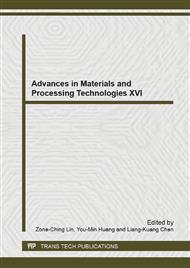p.506
p.517
p.524
p.530
p.539
p.547
p.555
p.563
p.570
Flow and Film-Forming Characteristics Analysis of Non-Newtonian Fluid Slot Coating
Abstract:
The slot coating process in the production of polymer films has a wide range of applications. However, the process cannot be systemized. This study used the computational fluid dynamics software Polyflow to analyze the slot coating process and investigate the influence that the process parameters have on the characteristics of thin-film coating to reduce the time and cost consumed in the experimental methods. The rheological characteristics of the non-Newtonian fluid used in this study were first identified by conducting experiments, and then configured in the simulation software for fitting with mathematical models. In addition, the models of the slot coating process were constructed, and the Arbitrary Lagrangian-Eulerian (ALE) calculation methods were then used in the Polyflow software. The simulation results were then compared to the experimental results and the findings reported in relevant literature, to determine the influence that the process parameters have on the characteristics of thin-film coating. The simulation results were represented graphically in a coating window plot. The comparison results indicate that the viscosity-shear rate characteristic of the material in the shear rate range of optical film coating is an excellent fit for the Cross Law. When the coating speed is too high or the amount of fluid supply is insufficient, phenomena such as break lines, uneven thickness, and air entrainment can occur.
Info:
Periodical:
Pages:
539-546
Citation:
Online since:
May 2014
Authors:
Price:
Сopyright:
© 2014 Trans Tech Publications Ltd. All Rights Reserved
Share:
Citation:


